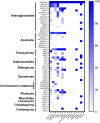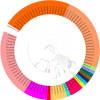Antimicrobial resistance and genomic investigation of non-typhoidal Salmonella isolated from outpatients in Shaoxing city, China
- PMID: 36176509
- PMCID: PMC9513250
- DOI: 10.3389/fpubh.2022.988317
Antimicrobial resistance and genomic investigation of non-typhoidal Salmonella isolated from outpatients in Shaoxing city, China
Abstract
Human non-typhoidal salmonellosis is among the leading cause of morbidity and mortality worldwide, resulting in huge economic losses and threatening the public health systems. To date, epidemiological characteristics of non-typhoidal Salmonella (NTS) implicated in human salmonellosis in China are still obscure. Herein, we investigate the antimicrobial resistance and genomic features of NTS isolated from outpatients in Shaoxing city in 2020. Eighty-seven Salmonella isolates were recovered and tested against 28 different antimicrobial agents, representing 12 categories. The results showed high resistance to cefazolin (86.21%), streptomycin (81.61%), ampicillin (77.01%), ampicillin-sulbactam (74.71%), doxycycline (72.41%), tetracycline (71.26%), and levofloxacin (70.11%). Moreover, 83.91% of isolates were resistant to ≥3 categories, which were considered multi-drug resistant (MDR). Whole-genome sequencing (WGS) combined with bioinformatic analysis was used to predict serovars, MLST types, plasmid replicons, antimicrobial resistance genes, and virulence genes, in addition to the construction of phylogenomic to determine the epidemiological relatedness between isolates. Fifteen serovars and 16 STs were identified, with the dominance of S. I 4, [5], 12:i:- ST34 (25.29%), S. Enteritidis ST11 (22.99%), and S. Typhimurium ST19. Additionally, 50 resistance genes representing ten categories were detected with a high prevalence of aac(6')-Iaa (100%), bla TEM-1B (65.52%), and tet(A) (52.87%), encoding resistance to aminoglycosides, β-lactams, and tetracyclines, respectively; in addition to chromosomic mutations affecting gyrA gene. Moreover, we showed the detection of 18 different plasmids with the dominance of IncFIB(S) and IncFII(S) (39.08%). Interestingly, all isolates harbor the typical virulence genes implicated in the virulence mechanisms of Salmonella, while one isolate of S. Jangwani contains the cdtB gene encoding typhoid toxin production. Furthermore, the phylogenomic analysis showed that all isolates of the same serovar are very close to each other and clustered together in the same clade. Together, we showed a high incidence of MDR among the studied isolates which is alarming for public health services and is a major threat to the currently available treatments to deal with human salmonellosis; hence, efforts should be gathered to further introduce WGS in routinely monitoring of AMR Salmonella in the medical field in order to enhance the effectiveness of surveillance systems and to limit the spread of MDR clones.
Keywords: antimicrobial resistance; gastroenteritis; non-typhoidal Salmonella; public health; salmonellosis; virulence; whole genome sequencing.
Copyright © 2022 Chen, Ed-Dra, Zhou, Wu, Zhang and Yue.
Conflict of interest statement
The authors declare that the research was conducted in the absence of any commercial or financial relationships that could be construed as a potential conflict of interest.
Figures






Similar articles
-
Genome-Based Assessment of Antimicrobial Resistance and Virulence Potential of Isolates of Non-Pullorum/Gallinarum Salmonella Serovars Recovered from Dead Poultry in China.Microbiol Spectr. 2022 Aug 31;10(4):e0096522. doi: 10.1128/spectrum.00965-22. Epub 2022 Jun 21. Microbiol Spectr. 2022. PMID: 35727054 Free PMC article.
-
Genomic Epidemiology of Multidrug-Resistant Nontyphoidal Salmonella in Young Children Hospitalized for Gastroenteritis.Microbiol Spectr. 2021 Sep 3;9(1):e0024821. doi: 10.1128/Spectrum.00248-21. Epub 2021 Aug 4. Microbiol Spectr. 2021. PMID: 34346743 Free PMC article.
-
Serovar and sequence type distribution and phenotypic and genotypic antimicrobial resistance of Salmonella originating from pet animals in Chongqing, China.Microbiol Spectr. 2024 Jul 2;12(7):e0354223. doi: 10.1128/spectrum.03542-23. Epub 2024 May 17. Microbiol Spectr. 2024. PMID: 38757951 Free PMC article.
-
Antimicrobial Resistance in Nontyphoidal Salmonella Isolated from Human and Poultry-Related Samples in Brazil: 20-Year Meta-Analysis.Foodborne Pathog Dis. 2017 Feb;14(2):116-124. doi: 10.1089/fpd.2016.2228. Epub 2016 Dec 6. Foodborne Pathog Dis. 2017. PMID: 27922763
-
Tackling salmonellosis: A comprehensive exploration of risks factors, impacts, and solutions.Open Vet J. 2024 Jun;14(6):1313-1329. doi: 10.5455/OVJ.2024.v14.i6.1. Epub 2024 Jun 30. Open Vet J. 2024. PMID: 39055762 Free PMC article. Review.
Cited by
-
Antimicrobial resistance and genomic investigation of Salmonella isolated from retail foods in Guizhou, China.Front Microbiol. 2024 Mar 6;15:1345045. doi: 10.3389/fmicb.2024.1345045. eCollection 2024. Front Microbiol. 2024. PMID: 38510999 Free PMC article.
-
Molecular Characteristics of Salmonella Spp. Responsible for Bloodstream Infections in a Tertiary Hospital in Nanjing, China, 2019-2021.Infect Drug Resist. 2024 Jun 12;17:2363-2377. doi: 10.2147/IDR.S459941. eCollection 2024. Infect Drug Resist. 2024. PMID: 38894888 Free PMC article.
-
Antimicrobial Resistance and Genomic Characterization of Salmonella Serovars Typhimurium and 4,[5],12:i:- in Huzhou, China.Infect Drug Resist. 2025 May 31;18:2765-2777. doi: 10.2147/IDR.S521802. eCollection 2025. Infect Drug Resist. 2025. PMID: 40469478 Free PMC article.
-
Genomic characterization of Salmonella isolated from retail chicken and humans with diarrhea in Qingdao, China.Front Microbiol. 2023 Dec 18;14:1295769. doi: 10.3389/fmicb.2023.1295769. eCollection 2023. Front Microbiol. 2023. PMID: 38164401 Free PMC article.
-
Whole-Genome Sequencing Analysis of Non-Typhoidal Salmonella Isolated from Breeder Poultry Farm Sources in China, 2020-2021.Antibiotics (Basel). 2023 Nov 19;12(11):1642. doi: 10.3390/antibiotics12111642. Antibiotics (Basel). 2023. PMID: 37998844 Free PMC article.
References
Publication types
MeSH terms
Substances
LinkOut - more resources
Full Text Sources
Medical

